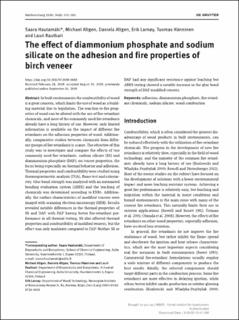| dc.contributor.author | Hautamaki, Saara | |
| dc.contributor.author | Altgen, Michael | |
| dc.contributor.author | Altgen, Daniela | |
| dc.contributor.author | Larnøy, Erik | |
| dc.contributor.author | Hanninen, Tuomas | |
| dc.contributor.author | Rautkari, Lauri | |
| dc.date.accessioned | 2020-04-16T12:19:16Z | |
| dc.date.available | 2020-04-16T12:19:16Z | |
| dc.date.created | 2019-11-19T16:22:51Z | |
| dc.date.issued | 2019-09-24 | |
| dc.identifier.citation | Holzforschung. 2019, . | en_US |
| dc.identifier.issn | 0018-3830 | |
| dc.identifier.uri | https://hdl.handle.net/11250/2651323 | |
| dc.description.abstract | In built environments the combustibility of wood is a great concern, which limits the use of wood as a building material due to legislation. The reaction-to-fire properties of wood can be altered with the use of fire-retardant chemicals, and most of the commonly used fire retardants already have a long history of use. However, only limited information is available on the impact of different fire retardants on the adhesion properties of wood. Additionally, comparative studies between chemicals from different groups of fire retardants is scarce. The objective of this study was to investigate and compare the effects of two commonly used fire retardants, sodium silicate (SS) and diammonium phosphate (DAP), on veneer properties, the focus being especially on thermal behavior and adhesion. Thermal properties and combustibility were studied using thermogravimetric analysis (TGA), flame test and calorimetry. Glue bond strength was analyzed with an automated bonding evaluation system (ABES) and the leaching of chemicals was determined according to EN84. Additionally, the surface characteristics of modified veneers were imaged with scanning electron microscopy (SEM). Results revealed notable differences in the thermal properties of SS and DAP, with DAP having better fire-retardant performance in all thermal testing. SS also affected thermal properties and combustibility of modified veneers, but the effect was only moderate compared to DAP. Neither SS or DAP had any significant resistance against leaching but ABES testing showed a notable increase in the glue bond strength of DAP modified veneers. | en_US |
| dc.language.iso | eng | en_US |
| dc.rights | Attribution-NonCommercial-NoDerivatives 4.0 Internasjonal | * |
| dc.rights.uri | http://creativecommons.org/licenses/by-nc-nd/4.0/deed.no | * |
| dc.title | The effect of diammonium phosphate and sodium silicate on the adhesion and fire properties of birch veneer | en_US |
| dc.type | Peer reviewed | en_US |
| dc.type | Journal article | en_US |
| dc.description.version | publishedVersion | en_US |
| dc.rights.holder | ©2020 Walter de Gruyter GmbH, Berlin/Boston | en_US |
| dc.subject.nsi | VDP::Landbruks- og Fiskerifag: 900 | en_US |
| dc.source.pagenumber | 10 | en_US |
| dc.source.journal | Holzforschung | en_US |
| dc.identifier.doi | 10.1515/hf-2019-0059 | |
| dc.identifier.cristin | 1749581 | |
| dc.relation.project | EU/18/13.01/2016 | en_US |
| cristin.ispublished | true | |
| cristin.fulltext | original | |
| cristin.qualitycode | 1 | |

